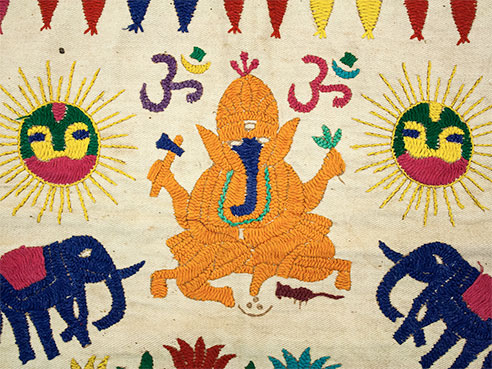 Works of art made by women in rural India and prints from post-war Japan will be featured in two exhibitions presented by the University of Alabama at BirminghamDepartment of Art and Art History from June 5-July 17.
Works of art made by women in rural India and prints from post-war Japan will be featured in two exhibitions presented by the University of Alabama at BirminghamDepartment of Art and Art History from June 5-July 17.
Each exhibition will be on show in the UAB Abroms-Engel Institute for the Visual Arts, 1221 10th Ave. South. A free opening reception is planned for 5-7:30 p.m. Friday, June 6.
“Objects of Authority: Embroideries and Other Contemporary Arts from Western India,” curated by UAB Assistant Professor of Art History Cathleen Cummings and co-curated by UAB Associate Professor of English Cynthia Ryan, will feature approximately 40 works of art produced in rural contexts in India over the past 50 years. Older, heirloom embroideries from Gujarat will be juxtaposed with those produced in the last few years under the aegis of Indian nongovernmental organizations to highlight the effects of commodification on artistic production and the aesthetic results.
 Cummings and Ryan together have traveled to India to research how social change and tourism have affected the traditional domestic textiles made by women. The exhibition reflects the reinvention of the notion of art versus craft and of art and authenticity, and the context of lower-class village women who create the textiles but are not traditionally considered artists. The exhibition also will feature paintings and textiles from Madhya Pradesh and Bihar, where aesthetic modifications similar to those in Gujarat have occurred, to draw attention to the intersections of market needs and artistic invention that have resulted in new aesthetic traditions cropping up across these regions.
Cummings and Ryan together have traveled to India to research how social change and tourism have affected the traditional domestic textiles made by women. The exhibition reflects the reinvention of the notion of art versus craft and of art and authenticity, and the context of lower-class village women who create the textiles but are not traditionally considered artists. The exhibition also will feature paintings and textiles from Madhya Pradesh and Bihar, where aesthetic modifications similar to those in Gujarat have occurred, to draw attention to the intersections of market needs and artistic invention that have resulted in new aesthetic traditions cropping up across these regions.
“After Sōsaku Hanga: Creativity and Modernity in Japanese Prints of the 1960s and 1970s,” also curated by Cummings, explores the works of sōsaku hanga printmakers of post-war Japan. The works have been selected to explore the growing influence of the West on traditional Japanese print aesthetics. All prints are from the permanent collection of the Birmingham Museum of Art.
 Unlike traditional Japanese prints of the ukiyo-e tradition, which were made through a collaboration between artist, block-carver, printer and publisher, artists of the sōsaku hanga tradition sought individual and highly personalized expression in their works, and executed all stages of the print-production process themselves. Their works blended established Japanese aesthetics with the influence of modern and contemporary art of the West. The exhibition features many of the movement’s most important artists, including Watanabe Sadao, Umetaro Azechi and Mori Yoshitoshi, working in the 1960s and 1970s — a time of great cultural flux in Japan.
Unlike traditional Japanese prints of the ukiyo-e tradition, which were made through a collaboration between artist, block-carver, printer and publisher, artists of the sōsaku hanga tradition sought individual and highly personalized expression in their works, and executed all stages of the print-production process themselves. Their works blended established Japanese aesthetics with the influence of modern and contemporary art of the West. The exhibition features many of the movement’s most important artists, including Watanabe Sadao, Umetaro Azechi and Mori Yoshitoshi, working in the 1960s and 1970s — a time of great cultural flux in Japan.
“After Sōsaku Hanga” will be a companion exhibition to the BMA’s exhibition, “Shin Hanga: Japanese Prints from the 1920s and 1930s.” The sōsaku hanga movement ran counter to the shin hanga movement, the prints of which were aimed largely at Western audiences and promoted a nostalgic view of traditional Japanese subjects, such as beautiful women and landscapes. The tensions between these movements reflect the stresses within Japan and the Japanese art world during the 20th century, Cummings says.
 Admission to the exhibitions is free. The AEIVA is open to the public 10 a.m.-6 p.m. Monday-Friday and 12-6 p.m. Saturday and is closed Sundays and holidays. For more information, contact Cummings at cathleen@uab.edu or visit the UAB Department of Art and Art History online or the AEIVA online.
Admission to the exhibitions is free. The AEIVA is open to the public 10 a.m.-6 p.m. Monday-Friday and 12-6 p.m. Saturday and is closed Sundays and holidays. For more information, contact Cummings at cathleen@uab.edu or visit the UAB Department of Art and Art History online or the AEIVA online.
Several students from Cummings’ recent graduate seminar have participated in curating the Indian exhibition. Contemporary production of textiles in rural India reveals a trend of increasing female autonomy, say students Megan Moore and Amy Williamson.
“I have been studying the India NGOs that help women generate income by employing them to do embroidery work in their homes,” Williamson said. “Women who are part of one of these organizations not only have a means to support their families but have received social benefits, from increased respect in the family setting to women being elected city officials.”